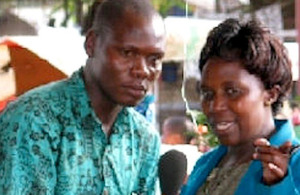DFID Research: Capacity strengthening for East African journalists
A pilot initiative to provide training to East African journalists alongside a major conference has helped strengthen links between researchers and the media.

Journalist Michael Wambi at work. Picture: Wrenmedia
Twelve journalists from Kenya, Tanzania and Uganda were selected to attend a 1 week DFID-funded training course held in parallel with a meeting on neglected plants attended by more than 200 researchers and experts from over 50 countries. The meeting was held in Arusha, Tanzania during early March 2008.
The symposium on “Underutilized plants for food, nutrition, income and sustainable development” provided the journalists with a focus for their reporting and the opportunity to improve their understanding of the issues. Sessions on content-gathering, photography, news and feature writing, as well as digital editing, also enabled them to improve their technical skills in science reporting. “The setting gave us the opportunity to meet scientists and to discuss the information, which helped to correct misunderstandings and avoid misreporting,” said Salome Alweny, a print journalist from Uganda.
The journalists then held an evening event “Making the most of the media” for interested participants from the conference to learn more about interacting with the press. The light-hearted event saw the journalists performing sketches, including caricatures of bad journalists/scientists in interview situations. It offered conference participants the chance to discuss the importance of making the most of the media and ways of developing good, clear messages appropriate to the audience.
The value of this short spin-off event was evident not only in the number of researchers who were then keen to interact with the journalists to highlight particular issues presented at the symposium, but also in raising the profile of the journalists, so that participants were aware of their presence and the intended radio/print outputs from the week. The journalists also felt it helped their confidence in capturing and sharing science stories, and that their contribution to communicating science was taken more seriously. “This week has helped to build relationships and friendships between the research community and the media,” said Lazarus Laiser, a radio journalist from Arusha, Tanzania. “The participants have also learned we are an effective channel for them to convey their messages to farmers and the wider public.”
Outputs from the training included and a summary of viewpoints in the current edition of New Agriculturist, a series of radio programmes on making more of neglected species (see ), distributed - with additional support from - to over 200 radio stations across Africa, as well as radio features and print articles for the journalists’ own programmes and publications in three countries. A selection of case studies written by the journalists will also appear on the website.
Following the success of this initiative to provide training for journalists alongside a major science conference, further training will be provided by WRENmedia for Southern African journalists later in 2008, at the World Conference on Animal Production, and at two more events, yet to be decided, in 2009.
More information
Read the Communicating research: contributing to sustainable development. Science reporting capacity building workshop for journalists and researchers, Arusha, Tanzania, March 2008
See also the record on R4D for the Wrenmedia Agfax II and New Agriculturist.